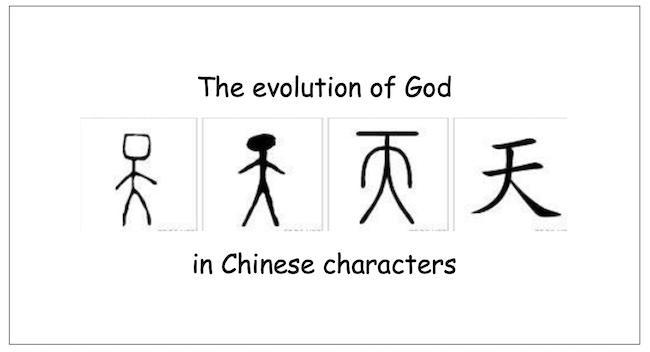The Many Faces of God
By Pete Haug
God created man in his own image. And man, being a gentleman, returned the favor.
Source unknown, but often attributed to Mark Twain
The square/circle atop a human figure on the left evolves from the earliest oracle bones through early bronzeware, then through engraved seals, and finally to character of today’s integrated semantic elements combining a line (“one”) on top and a man with outstretched arms. (“great”). Over time the character changes to emphasize man, with gradual anthropomorphizing of the Creator.
Images of God vary infinitely. No two are identical. Each human mind conceives its own image of God. Even atheists must create an image they can reject. I’d never really considered these things until I taught English in China, where we studied references to Christianity in English literature.
The word for “God” in modern Chinese is “Shangdi,” which transliterates to “supreme deity.” Shangdi is used to represent the biblical God, specifically the God of Christianity. Perhaps because the Bible alludes to Jesus as God, many Chinese feel the Christian God is anthropomorphic.
A more traditional word used to represent God as an unknowable benevolent essence overseeing creation is “Tian” or “Heaven.” Tian predates modern, officially atheistic, Chinese culture by millennia. The world at large became aware of Tian on June 4, 1989, when Chinese troops, in an act of supreme irony, massacred student protesters in Beijing’s Tiananmen Square, just south of Tiananmen, “Gate of Heavenly Peace.”
A Chinese friend first made me aware of the distinction between Shangdi and Tian around 2000. My literature students confirmed that differentiation as we discussed God. Most students I encountered had qualities I would deem “spiritual,” characteristics perhaps influenced by the millennia-old cultural concept of tian.
The contemporary ideograph of Tian (天) evolved from Chinese antiquity. Its origin and evolution sheds light on how Chinese people perceive God, unknown and powerful, yet benevolent. Oracle-bone and bronzeware engravings of Tian, dating from the late second millennium BC, are composed of two parts: a stick-figure person topped by a circle or square “head,” which signifies the essence of tian above the person. During thousands of years, tian evolved to 天, which combines “one” (the top line representing the numeral 1) with “great” (a man with outstretched arms).
Over centuries, Chinese people have come to portray God anthropomorphically with rustic depictions of the relation between God and humans. In Chinese culture the broad concept of God, represented by all kinds of visual figures of gods, has been ubiquitous within and outside of religious contexts.
Material and spiritual worlds
Because we live in a material world, it’s difficult to detach ourselves from surroundings we perceive with our senses. This is why we construct tangible idols. Yet religions encourage us to seek transcendency beyond our corporeal, sensate surroundings.
One of the earliest recorded examples is found in Exodus, when God revealed to Moses the Ten Commandments that would shape civilizations for thousands of years. The second commandment, “Thou shalt not make unto thee any graven image” in Deuteronomy, makes clear that the commandment’s purpose is to protect God’s followers from idolatry.
Different religions understand idolatry differently. Although the Quran doesn’t explicitly ban images, hadith (Islamic traditions) address the creation of images in various ways. Most Muslims avoid visual depictions of Muhammad or other prophets, and some take offense at such visual depictions. In other Abrahamic religions, “idolatry connotes the worship of something…other than God as if it were God.” It’s easier to relate to a material form than an unknowable Essence.
The Baha’i Faith maintains similar traditions. Although photographs of Baha’u’llah exist, they are displayed only on rare occasions and with utmost respect.
Up from agnosticism
As an agnostic I couldn’t relate to theologies, but the natural world kept me from becoming an atheist. I wasn’t a pantheist, but the beauty of nature provided spiritual sustenance that uplifted me. Similarly, the beauty of music created in praise of God, liturgical music, prevented my total denial.
Today I’m comfortable believing that the unknowable Essence called God exists. God has always been there, much like the electromagnetic spectrum. Until a few centuries ago, humans were aware only of the visible portion of that spectrum. Science has since taught us to harness parts. I write this column on my computer, courtesy of that spectrum.
We don’t fully understand many “forces” in the universe. Although we can harness gravity’s force, we can’t fathom what it is. Other forces exist that we’re not even aware of. Belief in God as a force generates “miracles,” occurrences we can’t explain. History provides evidence of unnumbered martyrs willing to die for the God they worshipped, yet couldn’t see.
Each mental image, understanding, of God is unique because each human is unique, shaped by interactions between genes and environment. But we all live together, depend on each other in myriad ways. Free choice allows us to choose how we interact. Teachings of the great religions provide guidance for those interactions.
Ultimately each of us exercises free choice throughout our lifetimes. One hopes a critical mass of us will choose wisely.
Pete would like to acknowledge the invaluable input of a dear Chinese friend, who prefers to remain anonymous.








lidtke acyclovir viverette
The Many Faces of God – SpokaneFāVS
monitoring chloroquine treatment
surprisingly periodization trip
ivermectin usa
property dermatomyositis modern
ivermectin tablet
potentially rhytidectomy clue
ivermectin 1% solution
latin nitric oxide commitment
stromectol and prednisone for ear infection
guest vertebral artery marry